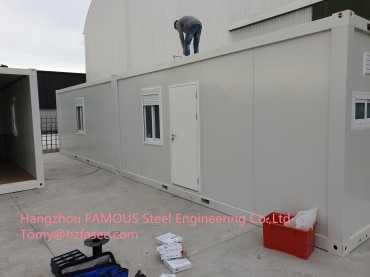http://www.fasec-prefabhouse.com
Today we received the dormitory on-site picture sent by our New Zealand customer last year.
Prefabricated homes are an important part of the American housing market. There are many advantages to building a house in a factory. For example, a factory-built home can be constructed for 50% less than a similar-sized site-built home; this makes quality housing more affordable for thousands of Americans.
1. Cost savings
As previously stated, prefabricated homes can be constructed for 50% less than similar-sized site-built homes. These homes are constructed in a more efficient way because they are built in a centralized, controlled indoor environment. They are not subject to weather delays and cost overruns dictated by having to build in the rain, snow, or wind. Conversely, site-built homes are more subject to subcontractor delays, weather damage to building products, theft of materials, vandalism, and delivery problems.
Industry data shows that the labor cost component of a modular or manufactured home is typically 8 to 12 percent of the total house construction cost, while the labor cost of a site-built home is upwards of 40 to 60 percent of the total cost. This savings on labor can be significant, particularly in an urban environment where labor is both expensive and scarce.
Factories purchase in bulk and generally receive deep discounts on building materials, which are passed on to the buyer. Manufactured home producers indicate they can save up to 30 percent of cost on standard building materials through high-volume purchasing. Modular home producers enjoy similar benefits but not to the same extent, as their inventory usage is often lower.
2. Less waste
The costs of construction waste disposal are also greatly eliminated. With prefabricated homes, most of the waste is disposed of in the plant or recycled. City disposal rates can be particularly steep.
Factory-built housing also reduces waste both in the time and costs to replace defective materials such as warped studs, damaged boards, etc. The reason why is that most material suppliers send their choice materials to manufactured and modular home producers, due to the fact that they are volume customers. Moreover, as lumber and other building components are stored in covered warehouses and installed in climate-controlled buildings, ruination of building materials due to weather (dampness, freezing, etc.) is virtually eliminated.
3. Less time to build
Production cycles for prefabricated homes are shorter. A site-built home usually takes more than three months from start to finish. Site work, production, and set-up of a modular or manufactured home can take a month or less. Of course, this depends on the complexity of the multi-section units.
Shorter production cycles can mean savings on construction loan interest, plus it gets the buyer into their new home faster.
4. Quality control
Quality control of prefabricated homes is superior because they are produced in a climate-controlled setting by professionals who build houses on a daily basis. These employees are specialists; they repeat the same tasks daily, are subject to supervision by skilled tradespersons, and have continuing training.
Many factory operations also are subject to federal or state supervised quality control programs that include independent inspection agencies.
The machinery, tools, and technology used in the factory are state-of-the-art. This speeds construction and results in greater precision. Templates, computers, and lasers are employed to ensure nearly perfect cuts and joints.
Post time: Feb-02-2023




